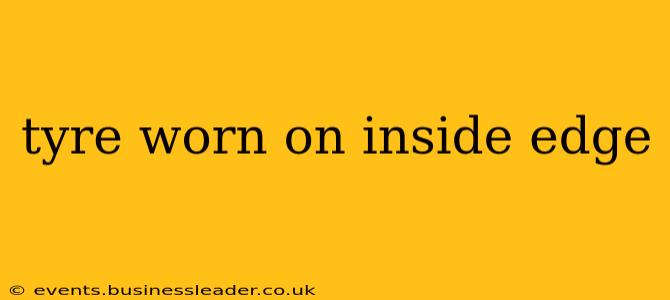Uneven tyre wear is a common problem, and a tyre worn on the inside edge is a particularly concerning issue. This isn't just about aesthetics; it significantly impacts your safety and handling, potentially leading to dangerous situations. This comprehensive guide will explore the reasons behind this type of wear, the risks involved, and how to prevent or address it.
What Causes Inside Tyre Wear?
Several factors can contribute to excessive wear on the inside edges of your tyres. Let's examine the most common culprits:
1. Incorrect Camber Angle:
This is often the primary reason. Camber refers to the angle of your wheels as viewed from the front of your car. A negative camber (the top of the wheel leans inwards) can cause the inside edge of the tyre to contact the road more aggressively, leading to faster wear. Positive camber (the top of the wheel leans outwards) is less common but can also contribute to uneven wear, though typically on the outside edge.
2. Worn or Damaged Suspension Components:
Faulty suspension components like ball joints, tie rod ends, and control arm bushings can alter your vehicle's alignment, indirectly causing negative camber and inside tyre wear. These parts wear over time and need replacing. Ignoring worn suspension can compromise your car's handling and safety beyond just tyre wear.
3. Improper Tyre Inflation:
Under-inflated tyres have a larger contact patch, increasing the pressure on the inside edges and promoting wear. Always check your tyre pressure regularly and inflate them to the manufacturer's recommended pressure (found in your owner's manual or on a sticker inside the driver's side doorjamb).
4. Excessive Cornering:
Aggressive driving habits, such as consistently taking corners at high speed, can put extra strain on the inside tyres, accelerating wear on their inner edges. This is particularly noticeable in vehicles with already slightly negative camber settings.
5. Worn Steering Components:
Worn or damaged steering components can affect the alignment of your wheels, leading to uneven tyre wear. Just like with suspension, issues here should be professionally addressed.
Is Driving on Tyres Worn on the Inside Edge Dangerous?
Yes, absolutely. Driving with tyres worn excessively on the inside edges presents several significant risks:
- Reduced Traction: This is the most immediate danger. Less tread on the inside edge means less grip, especially in wet or icy conditions. This can lead to loss of control and accidents.
- Increased Risk of Aquaplaning: The reduced contact patch makes aquaplaning more likely, further diminishing control in wet conditions.
- Uneven Braking: Uneven tyre wear can affect braking performance, potentially extending stopping distances and increasing your risk of collision.
- Premature Tyre Failure: Severely worn inside edges weaken the tyre structure, increasing the risk of blowouts or other failures.
How to Fix Inside Tyre Wear:
Addressing inside tyre wear requires a multifaceted approach:
- Wheel Alignment: This is crucial. A proper wheel alignment will correct any camber issues and ensure your tyres are properly positioned. Take your vehicle to a reputable tyre shop or garage for a professional alignment.
- Suspension Inspection: Have a mechanic inspect your suspension components for wear and tear. Replace any damaged parts as needed.
- Regular Tyre Pressure Checks: Maintain the correct tyre pressure as specified by your vehicle's manufacturer.
- Driving Habits: Adjust your driving style, avoiding excessively aggressive cornering.
- Tyre Replacement: If the wear is severe, you'll need to replace the affected tyres.
How Much Does It Cost to Fix Inside Tyre Wear?
The cost will vary depending on the underlying cause. A simple wheel alignment is relatively inexpensive, but repairing or replacing worn suspension components can be more costly. The price of new tyres will depend on your vehicle, tyre size, and brand. It's always better to address the underlying issue rather than just replacing tyres, as the problem will likely reoccur.
What if One Tyre Shows Inside Wear, but the Others Don't?
This is less common but indicates a problem with that specific wheel or suspension component on one side of the vehicle. It's essential to get your vehicle checked by a mechanic to identify the root cause. Ignoring it will likely lead to further damage and uneven wear on other tyres.
Can I Rotate My Tyres to Fix Inside Wear?
Tyre rotation won't fix the cause of inside tyre wear. It might temporarily redistribute wear, but the underlying alignment or suspension issue remains and will continue to cause problems. Rotation is a preventative maintenance measure, not a cure.
Addressing inside tyre wear is vital for safety and longevity of your tyres. Don't ignore this issue – get your vehicle inspected by a professional to identify and correct the underlying problem promptly.
